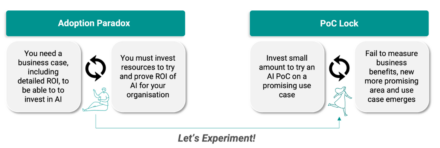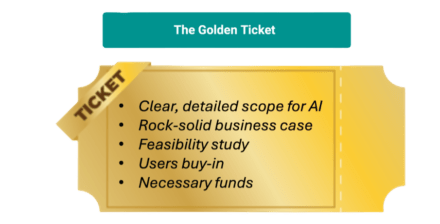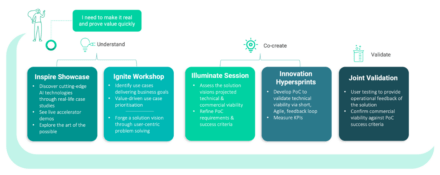6 min read
Cracking the AI Adoption Paradox
Cracking the AI Paradox, from Pilots and Proof of Concept (PoC) to innovative solutions.
Introduction
Artificial Intelligence (AI) presents unparalleled opportunities for innovation, but capitalising on these opportunities is far from straightforward. Organisations often find themselves in a paradoxical situation, which is common when adopting new, disruptive technologies. They must invest in AI to understand its applied potential and decide on a course of action, yet they need a clear business case and roadmap before committing resources.
Learn more about AI consultancy and implementation services.
The immediate answer would be ‘let’s start small and iterate, via a Pilot or Proof of Concept (PoC)’. However, this alone would not be the solution for this classic chicken-and-egg problem. In fact, this may result in organisations getting stuck in the ‘isolated, small-budget, sandbox, experimentation’ phase, endlessly iterating without progressing, with tight budgets that cannot be unlocked without clear ROI, which cannot be fully appreciated (especially the ‘cost’ part) before a full-tech exploration and optioneering.
Let’s refer to these concepts as the ‘Adoption Paradox’ and the ‘PoC lock’. In an unprecedented dynamic environment, characterised by constantly changing requirements, high-risk technologies, ethical and environmental impacts, as well as numerous unknowns, the demand for an agile and business-led approach, rather than a technology-pushed strategy, increases even more.

The big five key requirements
How can you overcome the above while still ensuring speed, business value, and considering ethical and environmental consequences?
- You need to inexpensively understand the art of the possible – you cannot innovate without knowing what is really possible
- You need to prioritise something of high value, not to waste resources, and measure its return on investment (ROI) as early as possible
- You need to understand feasibility and cost implications early, even before experimenting – it does not make sense to experiment on something that may cost billions if productionised
- You need user-centric solutions that align with business requirements – it does not make sense to invest onto something that has value, but that users won’t use
Speed is crucial; the cost of delay is the biggest cost nowadays.
What’s the right level of support?
If you already have a clear, detailed scope for AI, a rock-solid business case, a feasibility study that shows it’s doable and won’t soon become obsolete, and have gathered the necessary funds, then well done. You have the Golden Ticket.

However, if that’s not the case, which is common for most organisations, and you’re struggling to harness the benefits of AI, then help is at hand.
As Head of Cloud Innovation in Version 1’s AI Labs, which aims to educate organisations on AI and work with them on their innovation ambitions via experimentation while driving internal R&D to accelerate our and our clients’ AI adoptions. We offer workshops to explain what AI is, how to apply it in your industry, and showcase live demos and accelerators. But here’s the key – solving the adoption paradox and PoC lock requires more than just knowing what can be done. This is just the first step.
Co-Creation with the Version 1 AI Labs
My team specialise in co-creation with customers, focused on user-centric design principles, particularly in applied AI. We drive AI solutions from concepts into practical, business-aligned solutions through collaborative processes prioritising customer needs and strategic objectives.
How does it work in practice?

Phase 1: Understand

As a starter, to get to the innovation edge, we conduct a session showcasing cutting-edge AI technologies through real-world use cases and live demos (show not tell) from previous engagements and R&D efforts.
Then, by using what we call ‘Version 1 AI Jigsaw’ we uncover and prioritise use cases based on expected value and tech and data feasibility. This helps us focus on the most promising opportunities. Within one daywe can develop a high-level business case, outlining the expected value, technical complexity, and costs of priority use cases, ensuring efficient resource allocation.
To ensure that the proposed solutions are desirable and user-centric, we employ design thinking methodologies. This collaborative process gathers user insights, aligns stakeholders and validates a solution vision.
The outputs of this phase set the foundation for AI adoption by quickly identifying valuable opportunities and validating them with users, ensuring that solutions are both viable and impactful.
Phase 2: Co-Create

This is where things get exciting. With a co-created vision for the solution, our experts would then follow the 80/20 Pareto rule, designing a PoC to validate 80% of the vision with 20% of the effort: timeboxed within max 2 to 4, 1-week, ‘hypersprints’. This rapid phase involves shaping the design of a PoC that can validate the hypotheses co-created with your organisation. We present this ‘canvas’ before any development begins, including clear costs, deliverables, and success criteria.
We then proceed with the Innovation ‘hypersprints’: one-week iterations with continuous client feedback to realise a solution that users can understand and try first-hand. This accelerated process is boosted by our internal IP accelerators, ensuring quick delivery of a real application that clients can play with and provide feedback on.
The outputs of this phase include the PoC clear terms of reference, hypotheses statement, success criteria, and a custom MVP working application for users to access.
Phase 3: Validate (& Next Steps)

At this stage, users can interact with the application with no need for ‘change management’ or ‘upskilling’, as they have been part of its actual design and development, by being in close contact with the development team. We, in fact, co-created it. In parallel, we can construct an agile development roadmap, updating the business case based on lessons learned, and user feedback. This includes a plan for production readiness and scaling, providing more detailed information on revenues and costs.
Outputs of this phase include the validated solution, an agile development roadmap, the updated business case, plan for production readiness and scaling: A quick, inexpensive, Golden Ticket – arguably the solution to PoC Lock, and Innovation Paradox.
Real-World Examples
Our collaborative approach has significantly impacted various sectors, helping over 30 organisations kickstart AI adoption and solve both the innovation paradox and PoC lock in more than 20 cases, bringing to production solutions at scale. Notable examples include:
National Museum of Computing and Dyslexia Association: We developed web applications to enable live hyper-personalisation of content, catering to different audience needs. These tools translate and simplify complex information, making it more accessible and user-friendly, thereby enhancing educational outreach and engagement.
Irish Public Sector Department: We designed a cutting-edge web app to automate the generation of functional and technical documentation, crucial for decoding legacy codebases. This innovation facilitates efficient, cost-effective application modernisation, significantly reducing the time and effort required for this critical process.
Version 1 Internal Bid Assistant: To streamline our own processes, we created an internal bid assistant that summarises requirements and accesses historical intel quickly. This tool helps gather vast documentation, summarise requirements, and seamlessly access use cases and case studies, thereby accelerating our response to customer queries and improving the efficiency of our bid processes.
An international company dedicated to sustainable development: We developed a domain-specific Virtual Assistant to provide rapid and reliable search capabilities across a vast repository of complex fire-safety regulation documentation. Designed with a human-centred approach, this assistant enables the customer’s professionals to access accurate, up-to-date information much more efficiently, empowering them to make informed decisions and deliver high-quality sustainable development solutions faster.
A Global Non-Profit: We created a live translator and simplificator for their website, enhancing accessibility by translating and personalising content based on audience age group and languages. This web app drastically improves the user experience, making complex information more understandable and accessible at a sustainable cost.
These examples illustrate how our co-creation approach delivers tangible benefits, solving real-world problems and driving AI adoption from proof-of-concept to production, at scale.
About the Author – Andrea Bureca

Andrea is the Head of Cloud Innovation at Version 1, driving customer-centric, collaborative R&D and advancing Version 1 Cloud & AI Innovation agenda. Passionate about designing, communicating, and delivering large-scale innovative solutions, Andrea has experience across over 10 industries in both public and private sectors and spanning 7 countries, developing a resilient mindset and a highly transferable skillset. His expertise includes AI, Cloud, Agile & DevOps, XR, and IoT, combined with Product and Innovation Management, Business Analysis, Design Thinking, and Agile Delivery.
Andrea holds two M.Sc. degrees in Innovation and Entrepreneurship and in Industrial Management, both earned summa cum laude, as well as a Bachelor’s in Economics.
Click here to get in touch with our Cloud Innovation and AI experts.
AI Consultancy and Implementation Services
Version 1 offers AI consultancy and implementation services with specialists available to support your organisation in maximising productivity by utilising AI, from POC to deployment.